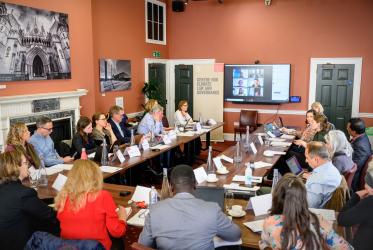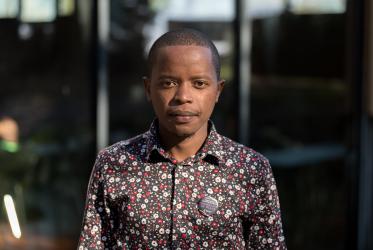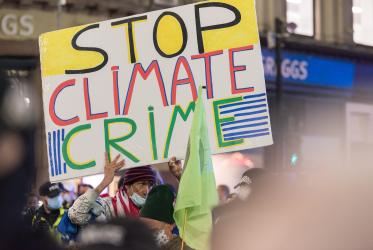*By Claus Grue
It is midnight and the sun just about hides for a little while beneath the horizon. The calm sea is scattered with icebergs in all kinds of shapes and sizes. Some are like five-story buildings, with vertical sharp-edged walls rising high above the surface. Others are more like snow-capped hilltops, slowly ploughing through the blank water.
This stunning scenery takes place each spring and summer in the Disko Bay area on the west coast of Greenland, 300 kilometres north of the Arctic Circle. When the weather gets warmer and the Sermeq Kujalleq glacier at the edge of the inland icecap is bathed in sunshine around the clock, huge icebergs are calved off and embark on 40-kilometre journey westwards through the Ilulissat Icefjord towards the open waters between Greenland and Canada. No other glacier in the Northern Hemisphere releases larger volumes of ice, an estimated 45 cubic kilometres every year.
Temperatures rise faster
In the last ten years, the speed with which the glacier moves has doubled from 20 to 40 meters per day. Larger volumes of calved ice from the inland ice sheet eventually melt in the ocean, causing rising water levels around the globe. Climate change eats into the edges of the Greenland icecap.
“This is happening much faster than previously anticipated. A higher-than-average temperature rise around the poles of the Earth has serious consequences, not only for the people living in these areas, but for all of us”, explains Henrik Grape, senior advisor for care and creation, sustainability and climate justice at the World Council of Churches (WCC).
The social and economic implications of global warming are evident. Traditional ways of living - and making a living, such as fishing and hunting, are threatened. The fauna in polar areas is changing and natural habitats for species, both on land and in water, are seriously affected.
“We get fish in our nets we haven’t seen here before, and the icy coastal areas, where polar bears jump around among icebergs hunting seal, are melting away. How sad it is to see this majestic, beautiful animal searching for food in garbage cans in the outskirts of our towns instead of thriving in its natural habitat”, says bishop Sofie Petersen, spiritual leader of the diocese of Greenland, and a long-time champion of sustainable development.
The climate relay initiative
Back in 2009 she brought “the climate relay” to Greenland, an ecumenical initiative designed to raise general awareness of climate change and place it on the agenda in local parishes. During the summer months she toured around the whole island, leading climate change-themed worships and seminars on the impact of global warming.
“That was just ten years ago, and I travelled in springtime by dogsled between settlements around Uummannaq in north-western Greenland. Nowadays, melting ice makes such means of transportation almost impossible this time of the year. In Ittoqqortoormiit, East Greenland, the church has had to close because melting permafrost has undermined its foundation, and in southern Greenland severe storms have become more frequent in recent years. Science has proved climate change to be a man-made phenomenon, which we are now seeing the severe consequences of”, explains Petersen.
God’s creation and commandments
She firmly believes that the church must be deeply engaged in a dialogue about global warming from two perspectives: How it affects what God has created and how it relates to his commandment “love thy neighbour like thyself”.
Bishop Sofie Petersen, diocese of Greenland. Photo Claus Grue/WCC
“We are not taking good care of God’s creation and that harms ourselves and our neighbours. We must nurture and respect nature as a critical source of life that can’t be bought back once we have destroyed it. There are no spare parts for whales and it will be too late to save Tuvalu and other islands, once rising ocean levels have drowned them”, Petersen argues.
The role of the church is thus to add a spiritual perspective on climate change-issues and raise awareness about how they relate to God’s creation and his commandments.
“This is a question of both science and faith. Climate change is based on scientific facts our faith can help us deal with – and hopefully prevent. What God has given us must not be misused and we bear full responsibility for the condition in which we hand over Mother Earth to our children”, Petersen continues.
Flying is necessary – with modesty
Sustainability and modesty are key words in her reasoning. She is clear about the need to stop consuming goods we really don’t need, such as fresh strawberries in January or imported roses from Africa.
“These are created needs driven by commercial interests elsewhere. Small changes in our consumption patterns, with more focus on essential needs, will make a difference”, she says.
In a large, remote and mostly ice-capped country, with no railways and no roads connecting populated areas, essential needs include civil aviation and sea-ferry transportation. At least to a certain extent, since they are the only means of getting around. Flying, according to the bishop, is absolutely necessary, but it doesn’t mean we shouldn’t think twice before we board a plane.
“It is easy to fly around and hold meetings about global warming, but perhaps we could reduce the number of air trips and coordinate our activities in a way that requires less flying. Again, it is a question of respect for God’s creation and small-scale contributions to a better climate”, the bishop explains.
Sustainable tourism welcome
Another environmental threat, and at the same time a commercial opportunity for Greenland, is the fast-growing tourism industry, which has become a major source of income for the island. Large cruise ships anchor along the western coastline in the summer and a seemingly endless flow of tourists from all over the world pour into the country.
Petersen foresees a need to protect Greenland’s delicate nature by legislative measures limiting the number of tourists allowed each season. Similar measures are already in place in neighbouring Iceland and the Faroe Islands.
“This is a situation we have created ourselves by being too generous - and too greedy. We want to welcome visitors and we appreciate their interest in our country. But again, modesty and sustainability are key if we want to preserve the precious environment tourists are coming here to see in the first place”, she says.
The area around the Ilulissat Fjord, where majestic icebergs pass by, is one of these environments. It was declared a UNESCO heritage site in 2004 and attracts a growing number of visitors from near and far.
As a native Greenlander, Petersen has always been close to nature and appreciated the simplistic way of life, predominant here.
Hearing the roaring sounds of whales breathing, watching polar bear cubs play on the icebergs, and travelling by dogsled over vast white landscapes is something she wouldn’t want to live without.
“I treasure this beautiful country”, she says.
*Claus Grue is a communication consultant for the World Council of Churches.
Greenland church life and climate challenges featured in new series (WCC press release 24 May 2019)




